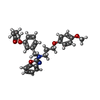+ データを開く
データを開く
- 基本情報
基本情報
| 登録情報 | データベース: PDB / ID: 6kaz | ||||||
|---|---|---|---|---|---|---|---|
| タイトル | X-ray structure of human PPARalpha ligand binding domain-pemafibrate co-crystals obtained by soaking | ||||||
 要素 要素 | Peroxisome proliferator-activated receptor alpha | ||||||
 キーワード キーワード | TRANSCRIPTION / Nuclear receptor / Protein-ligand complex / PPAR | ||||||
| 機能・相同性 |  機能・相同性情報 機能・相同性情報positive regulation of transformation of host cell by virus / regulation of fatty acid transport / enamel mineralization / positive regulation of fatty acid beta-oxidation / regulation of ketone metabolic process / cellular response to fructose stimulus / regulation of fatty acid metabolic process / negative regulation of cell growth involved in cardiac muscle cell development / negative regulation of appetite / negative regulation of hepatocyte apoptotic process ...positive regulation of transformation of host cell by virus / regulation of fatty acid transport / enamel mineralization / positive regulation of fatty acid beta-oxidation / regulation of ketone metabolic process / cellular response to fructose stimulus / regulation of fatty acid metabolic process / negative regulation of cell growth involved in cardiac muscle cell development / negative regulation of appetite / negative regulation of hepatocyte apoptotic process / lipoprotein metabolic process / positive regulation of fatty acid oxidation / behavioral response to nicotine / negative regulation of leukocyte cell-cell adhesion / negative regulation of glycolytic process / ubiquitin conjugating enzyme binding / mitogen-activated protein kinase kinase kinase binding / positive regulation of fatty acid metabolic process / DNA-binding transcription activator activity / NFAT protein binding / negative regulation of cholesterol storage / positive regulation of ATP biosynthetic process / nuclear steroid receptor activity / negative regulation of macrophage derived foam cell differentiation / epidermis development / phosphatase binding / positive regulation of lipid biosynthetic process / Transcriptional regulation of brown and beige adipocyte differentiation by EBF2 / negative regulation of blood pressure / intracellular receptor signaling pathway / nitric oxide metabolic process / negative regulation of reactive oxygen species biosynthetic process / hormone-mediated signaling pathway / : / Regulation of lipid metabolism by PPARalpha / MDM2/MDM4 family protein binding / peroxisome proliferator activated receptor signaling pathway / response to nutrient / positive regulation of gluconeogenesis / negative regulation of cytokine production involved in inflammatory response / negative regulation of phosphatidylinositol 3-kinase/protein kinase B signal transduction / BMAL1:CLOCK,NPAS2 activates circadian expression / Activation of gene expression by SREBF (SREBP) / negative regulation of miRNA transcription / cellular response to starvation / gluconeogenesis / SUMOylation of intracellular receptors / circadian regulation of gene expression / wound healing / Heme signaling / fatty acid metabolic process / negative regulation of transforming growth factor beta receptor signaling pathway / Transcriptional activation of mitochondrial biogenesis / PPARA activates gene expression / Cytoprotection by HMOX1 / response to insulin / regulation of circadian rhythm / Nuclear Receptor transcription pathway / Transcriptional regulation of white adipocyte differentiation / negative regulation of inflammatory response / DNA-binding transcription repressor activity, RNA polymerase II-specific / transcription coactivator binding / nuclear receptor activity / : / heart development / DNA-binding transcription activator activity, RNA polymerase II-specific / response to ethanol / gene expression / sequence-specific DNA binding / RNA polymerase II-specific DNA-binding transcription factor binding / DNA-binding transcription factor activity, RNA polymerase II-specific / cell differentiation / response to hypoxia / RNA polymerase II cis-regulatory region sequence-specific DNA binding / DNA-binding transcription factor activity / protein domain specific binding / lipid binding / chromatin / positive regulation of DNA-templated transcription / protein-containing complex binding / negative regulation of transcription by RNA polymerase II / positive regulation of transcription by RNA polymerase II / DNA binding / zinc ion binding / nucleoplasm / nucleus 類似検索 - 分子機能 | ||||||
| 生物種 |  Homo sapiens (ヒト) Homo sapiens (ヒト) | ||||||
| 手法 |  X線回折 / X線回折 /  シンクロトロン / シンクロトロン /  分子置換 / 解像度: 1.48 Å 分子置換 / 解像度: 1.48 Å | ||||||
 データ登録者 データ登録者 | Kamata, S. / Suda, K. / Saito, K. / Oyama, T. / Ishii, I. | ||||||
| 資金援助 |  日本, 1件 日本, 1件
| ||||||
 引用 引用 |  ジャーナル: Iscience / 年: 2020 ジャーナル: Iscience / 年: 2020タイトル: PPAR alpha Ligand-Binding Domain Structures with Endogenous Fatty Acids and Fibrates. 著者: Kamata, S. / Oyama, T. / Saito, K. / Honda, A. / Yamamoto, Y. / Suda, K. / Ishikawa, R. / Itoh, T. / Watanabe, Y. / Shibata, T. / Uchida, K. / Suematsu, M. / Ishii, I. | ||||||
| 履歴 |
|
- 構造の表示
構造の表示
| 構造ビューア | 分子:  Molmil Molmil Jmol/JSmol Jmol/JSmol |
|---|
- ダウンロードとリンク
ダウンロードとリンク
- ダウンロード
ダウンロード
| PDBx/mmCIF形式 |  6kaz.cif.gz 6kaz.cif.gz | 76.1 KB | 表示 |  PDBx/mmCIF形式 PDBx/mmCIF形式 |
|---|---|---|---|---|
| PDB形式 |  pdb6kaz.ent.gz pdb6kaz.ent.gz | 52.8 KB | 表示 |  PDB形式 PDB形式 |
| PDBx/mmJSON形式 |  6kaz.json.gz 6kaz.json.gz | ツリー表示 |  PDBx/mmJSON形式 PDBx/mmJSON形式 | |
| その他 |  その他のダウンロード その他のダウンロード |
-検証レポート
| 文書・要旨 |  6kaz_validation.pdf.gz 6kaz_validation.pdf.gz | 724.3 KB | 表示 |  wwPDB検証レポート wwPDB検証レポート |
|---|---|---|---|---|
| 文書・詳細版 |  6kaz_full_validation.pdf.gz 6kaz_full_validation.pdf.gz | 727.7 KB | 表示 | |
| XML形式データ |  6kaz_validation.xml.gz 6kaz_validation.xml.gz | 13.6 KB | 表示 | |
| CIF形式データ |  6kaz_validation.cif.gz 6kaz_validation.cif.gz | 19.7 KB | 表示 | |
| アーカイブディレクトリ |  https://data.pdbj.org/pub/pdb/validation_reports/ka/6kaz https://data.pdbj.org/pub/pdb/validation_reports/ka/6kaz ftp://data.pdbj.org/pub/pdb/validation_reports/ka/6kaz ftp://data.pdbj.org/pub/pdb/validation_reports/ka/6kaz | HTTPS FTP |
-関連構造データ
| 関連構造データ |  6kaxC 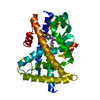 6kayC 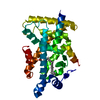 6kb0C 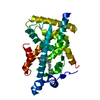 6kb1C 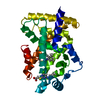 6kb2C 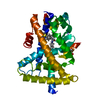 6kb3C 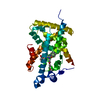 6kb4C 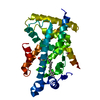 6kb5C 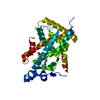 6kb6C  6kb7C 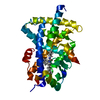 6kb8C  6kb9C  6kbaC 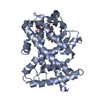 6kypC  6l36C 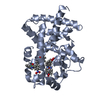 6l37C 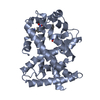 6l38C  6lx4C 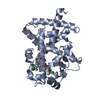 6lx5C  6lx6C 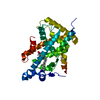 6lx7C 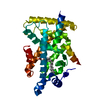 6lx8C  6lx9C 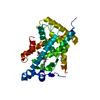 6lxaC  6lxbC 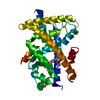 6lxcC  7bpyC  7bpzC  7bq0C  7bq1C  7bq2C  7bq3C  7bq4C 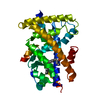 3vi8S S: 精密化の開始モデル C: 同じ文献を引用 ( |
|---|---|
| 類似構造データ |
- リンク
リンク
- 集合体
集合体
| 登録構造単位 | 
| ||||||||||
|---|---|---|---|---|---|---|---|---|---|---|---|
| 1 |
| ||||||||||
| 単位格子 |
|
- 要素
要素
| #1: タンパク質 | 分子量: 30856.053 Da / 分子数: 1 / 由来タイプ: 組換発現 / 由来: (組換発現)  Homo sapiens (ヒト) / 遺伝子: PPARA / プラスミド: pET28a / 発現宿主: Homo sapiens (ヒト) / 遺伝子: PPARA / プラスミド: pET28a / 発現宿主:  |
|---|---|
| #2: 化合物 | ChemComp-GOL / |
| #3: 化合物 | ChemComp-P7F / ( |
| #4: 水 | ChemComp-HOH / |
| 研究の焦点であるリガンドがあるか | Y |
-実験情報
-実験
| 実験 | 手法:  X線回折 / 使用した結晶の数: 1 X線回折 / 使用した結晶の数: 1 |
|---|
- 試料調製
試料調製
| 結晶 | マシュー密度: 2.27 Å3/Da / 溶媒含有率: 45.75 % |
|---|---|
| 結晶化 | 温度: 277 K / 手法: 蒸気拡散法 / 詳細: 0.1M Bis-Tris(pH 6.5), 25%(w/v) PEG3350 |
-データ収集
| 回折 | 平均測定温度: 100 K / Serial crystal experiment: N | |||||||||||||||||||||||||||
|---|---|---|---|---|---|---|---|---|---|---|---|---|---|---|---|---|---|---|---|---|---|---|---|---|---|---|---|---|
| 放射光源 | 由来:  シンクロトロン / サイト: シンクロトロン / サイト:  Photon Factory Photon Factory  / ビームライン: BL-5A / 波長: 1 Å / ビームライン: BL-5A / 波長: 1 Å | |||||||||||||||||||||||||||
| 検出器 | タイプ: DECTRIS PILATUS3 S 2M / 検出器: PIXEL / 日付: 2018年3月13日 / 詳細: Mirrors | |||||||||||||||||||||||||||
| 放射 | モノクロメーター: Si(111) / プロトコル: SINGLE WAVELENGTH / 単色(M)・ラウエ(L): M / 散乱光タイプ: x-ray | |||||||||||||||||||||||||||
| 放射波長 | 波長: 1 Å / 相対比: 1 | |||||||||||||||||||||||||||
| 反射 | 解像度: 1.48→42.96 Å / Num. obs: 45884 / % possible obs: 99.7 % / 冗長度: 3.3 % / Biso Wilson estimate: 16.08 Å2 / CC1/2: 0.999 / Rmerge(I) obs: 0.03 / Rpim(I) all: 0.019 / Rrim(I) all: 0.036 / Net I/σ(I): 19.7 / Num. measured all: 153302 | |||||||||||||||||||||||||||
| 反射 シェル | Diffraction-ID: 1
|
-位相決定
| 位相決定 | 手法:  分子置換 分子置換 | |||||||||
|---|---|---|---|---|---|---|---|---|---|---|
| Phasing MR |
|
- 解析
解析
| ソフトウェア |
| ||||||||||||||||
|---|---|---|---|---|---|---|---|---|---|---|---|---|---|---|---|---|---|
| 精密化 | 構造決定の手法:  分子置換 分子置換開始モデル: 3VI8 解像度: 1.48→28.974 Å / SU ML: 0.15 / 交差検証法: FREE R-VALUE / σ(F): 1.95 / 位相誤差: 19.57
| ||||||||||||||||
| 溶媒の処理 | 減衰半径: 0.9 Å / VDWプローブ半径: 1.11 Å | ||||||||||||||||
| 原子変位パラメータ | Biso mean: 21.106 Å2 | ||||||||||||||||
| 精密化ステップ | サイクル: LAST / 解像度: 1.48→28.974 Å
| ||||||||||||||||
| LS精密化 シェル | 解像度: 1.48→1.4968 Å / Rfactor Rfree error: 0
|
 ムービー
ムービー コントローラー
コントローラー





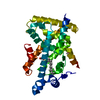


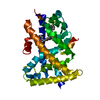


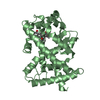



 PDBj
PDBj




